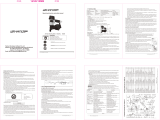
1 609 929 U14 | (14.1.10) Bosch Power Tools
20 | English
d)Disconnect the air supply before making any ad-
justments, changing accessories, or placing the
pneumatic tool aside. This safety measure prevents
accidental starting of the pneumatic tool.
e)Store idle pneumatic tools out of the reach of chil-
dren. Do not allow persons unfamiliar with the
pneumatic tool or these instructions to operate
the device. Pneumatic tools are dangerous in the
hands of untrained users.
f) Maintain the pneumatic tool with care. Check for
misalignment or binding of moving parts, breakage
of parts and any other condition that may affect
the pneumatic tool's operation. Have damaged
parts repaired before using the pneumatic tool.
Many accidents are caused by poorly maintained
pneumatic tools.
g)Use the pneumatic tool, accessories, application
tools, etc. according to these instructions. Take in-
to consideration the working conditions and the
activities to be carried out. Use of the pneumatic
tool for operations different from those intended
could result in hazardous situations.
5) Service
a)Have your pneumatic tool repaired only through a
qualified repair person and only using original re-
placement parts. This will ensure that the safety of
the pneumatic tool is maintained.
Safety Warnings for Compressed-air
Nailers/Staplers
Wear safety goggles.
f Always assume that the pneumatic tool is loaded
with fasteners. Careless handling of the pneumatic
tool can lead to unexpected shot actuation of fasten-
ers and cause injury.
f When working, hold the pneumatic tool in such a
manner that your head and body cannot be injured in
case of sudden kickback due to a malfunction of the
energy supply or from hard objects/locations in the
workpiece.
f Never point the pneumatic tool at yourself or at per-
sons close by. Unexpected actuation will expel a fas-
tener, which can lead to injury.
f Do not actuate the pneumatic tool until firmly placed
against the workpiece. When the pneumatic tool is not
in contact with the workpiece, the fastener can bounce
away from the fastening point and overload the pneu-
matic tool.
Do not work on ladders or scaffolds when the
actuation system “Contact actuation” is set.
In particular, do not move from one fastening
location to another, close boxes or enclo-
sures, or fasten transport-securing fixtures
on e.g., vehicles and waggons, via scaffolds,
stairs, ladders or ladder-like constructions,
such as roof battens. With this actuation sys-
tem, a fastener will be discharged each time
when accidentally applying the pneumatic tool
while the discharge lock-off is pressed in. This
can lead to injury.
f Observe the conditions of the job site. It is possible
that fasteners can burst through thin workpieces or be
deflected when working in corners or against edges,
and harm persons.
Disconnect the air supply, when the fasten-
er is jammed in the pneumatic tool. When
the pneumatic tool is still connected to the
power supply, it can accidentally be actuated
when removing a jammed fastener.
f Use caution when removing a jammed or stuck fas-
tener. The system can be under tension and cause the
fastener to be shot or thrust out, while attempting to
clear the jam.
f Do not use this to pneumatic tool to fasten electrical
wiring. It is not suitable for fastening electrical wiring,
can damage the insulation of electric cables and thus
lead to electric shock and danger of fire.
f Never use oxygen or flammable gases as the energy
source for the pneumatic tool. Flammable gases are
dangerous and can cause the pneumatic tool to ex-
plode.
f Use appropriate detectors to determine if utility lines
are hidden in the work area or call the local utility
company for assistance. Contact with electric lines
can lead to fire and electric shock. Damaging a gas line
can lead to explosion. Penetrating a water line causes
property damage or may cause an electric shock.
f The pneumatic tool may only be connected to lines,
for which the maximal permissible pressure of the
pneumatic tool cannot be exceeded by more than
10 %; for higher pressures, a pressure control valve
(pressure reducer) with preceding pressure-limita-
tion valve in the compressed-air line must be in-
stalled. Excessive pressure leads to abnormal opera-
tion or breakage of the pneumatic tool, which can lead
to injury.
OBJ_BUCH-1039-002.book Page 20 Thursday, January 14, 2010 6:17 PM
















